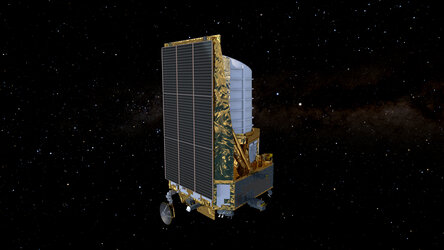

Euclid spacecraft
An artist impression of ESA’s Euclid mission in space. The spacecraft carries a 1.2-metre telescope that collect the light from sources in the sky such as far-away galaxies. The light is directed onto Euclid’s two scientific instruments: the visible camera VIS that will provide very sharp images, and the near-infrared spectrometer and photometer NISP which will provide both images and spectroscopic data, over the largest infrared field of view from space.
ESA's Euclid mission is designed to explore the composition and evolution of the dark Universe. The space telescope will create the largest, most accurate 3D map of the Universe across space and time by observing billions of galaxies out to 10 billion light-years, across more than a third of the sky. Euclid will explore how the Universe has expanded and how and how large-scale structure is distributed across space and time, revealing more about the role of gravity and the nature of dark energy and dark matter.





